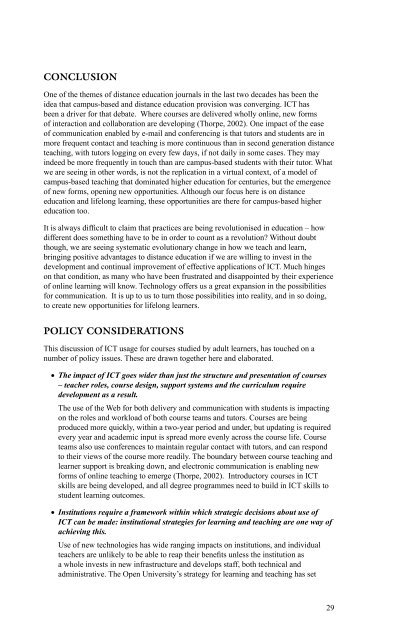lifelong learning and distance higher education - Asia Pacific Region
lifelong learning and distance higher education - Asia Pacific Region
lifelong learning and distance higher education - Asia Pacific Region
- No tags were found...
You also want an ePaper? Increase the reach of your titles
YUMPU automatically turns print PDFs into web optimized ePapers that Google loves.
CONCLUSIONOne of the themes of <strong>distance</strong> <strong>education</strong> journals in the last two decades has been theidea that campus-based <strong>and</strong> <strong>distance</strong> <strong>education</strong> provision was converging. ICT hasbeen a driver for that debate. Where courses are delivered wholly online, new formsof interaction <strong>and</strong> collaboration are developing (Thorpe, 2002). One impact of the easeof communication enabled by e-mail <strong>and</strong> conferencing is that tutors <strong>and</strong> students are inmore frequent contact <strong>and</strong> teaching is more continuous than in second generation <strong>distance</strong>teaching, with tutors logging on every few days, if not daily in some cases. They mayindeed be more frequently in touch than are campus-based students with their tutor. Whatwe are seeing in other words, is not the replication in a virtual context, of a model ofcampus-based teaching that dominated <strong>higher</strong> <strong>education</strong> for centuries, but the emergenceof new forms, opening new opportunities. Although our focus here is on <strong>distance</strong><strong>education</strong> <strong>and</strong> <strong>lifelong</strong> <strong>learning</strong>, these opportunities are there for campus-based <strong>higher</strong><strong>education</strong> too.It is always difficult to claim that practices are being revolutionised in <strong>education</strong> – howdifferent does something have to be in order to count as a revolution? Without doubtthough, we are seeing systematic evolutionary change in how we teach <strong>and</strong> learn,bringing positive advantages to <strong>distance</strong> <strong>education</strong> if we are willing to invest in thedevelopment <strong>and</strong> continual improvement of effective applications of ICT. Much hingeson that condition, as many who have been frustrated <strong>and</strong> disappointed by their experienceof online <strong>learning</strong> will know. Technology offers us a great expansion in the possibilitiesfor communication. It is up to us to turn those possibilities into reality, <strong>and</strong> in so doing,to create new opportunities for <strong>lifelong</strong> learners.POLICY CONSIDERATIONSThis discussion of ICT usage for courses studied by adult learners, has touched on anumber of policy issues. These are drawn together here <strong>and</strong> elaborated.• The impact of ICT goes wider than just the structure <strong>and</strong> presentation of courses– teacher roles, course design, support systems <strong>and</strong> the curriculum requiredevelopment as a result.The use of the Web for both delivery <strong>and</strong> communication with students is impactingon the roles <strong>and</strong> workload of both course teams <strong>and</strong> tutors. Courses are beingproduced more quickly, within a two-year period <strong>and</strong> under, but updating is requiredevery year <strong>and</strong> academic input is spread more evenly across the course life. Courseteams also use conferences to maintain regular contact with tutors, <strong>and</strong> can respondto their views of the course more readily. The boundary between course teaching <strong>and</strong>learner support is breaking down, <strong>and</strong> electronic communication is enabling newforms of online teaching to emerge (Thorpe, 2002). Introductory courses in ICTskills are being developed, <strong>and</strong> all degree programmes need to build in ICT skills tostudent <strong>learning</strong> outcomes.• Institutions require a framework within which strategic decisions about use ofICT can be made: institutional strategies for <strong>learning</strong> <strong>and</strong> teaching are one way ofachieving this.Use of new technologies has wide ranging impacts on institutions, <strong>and</strong> individualteachers are unlikely to be able to reap their benefits unless the institution asa whole invests in new infrastructure <strong>and</strong> develops staff, both technical <strong>and</strong>administrative. The Open University’s strategy for <strong>learning</strong> <strong>and</strong> teaching has set29
















